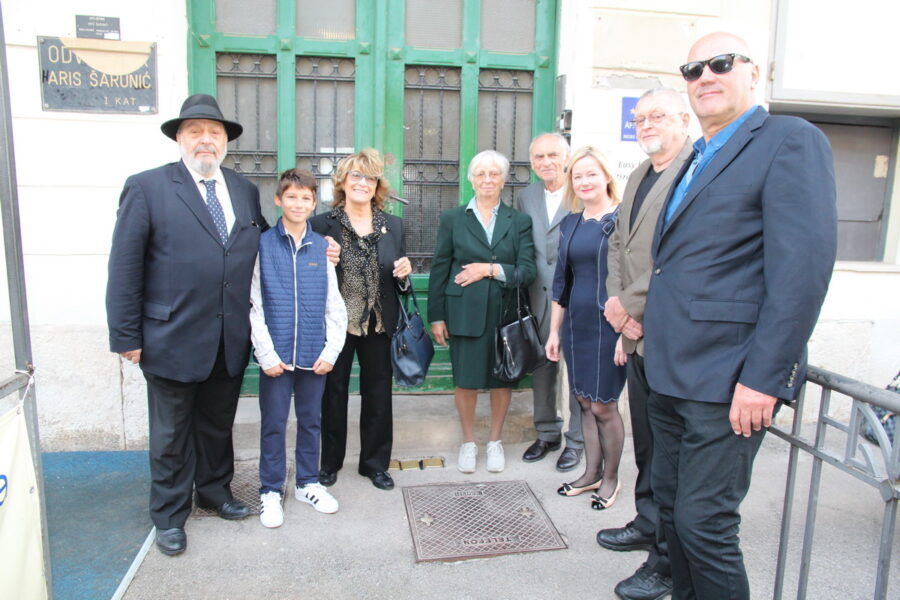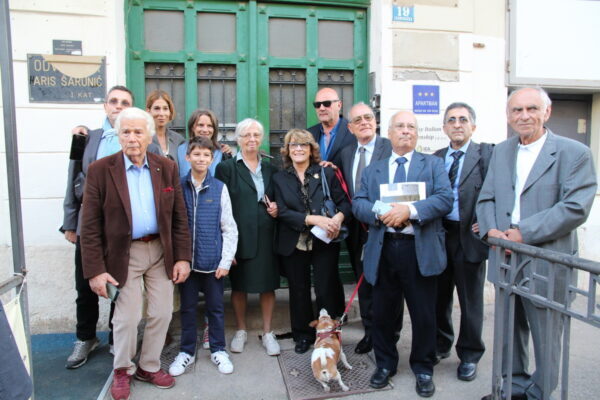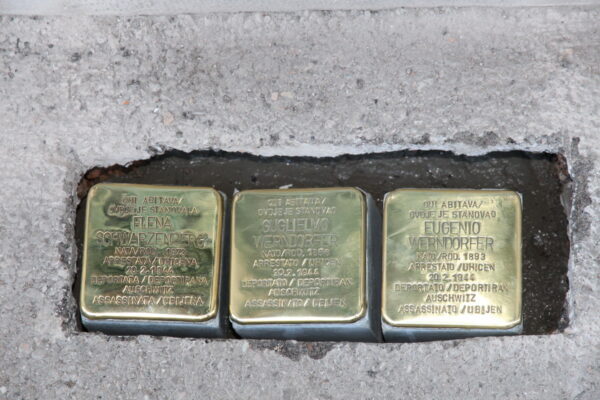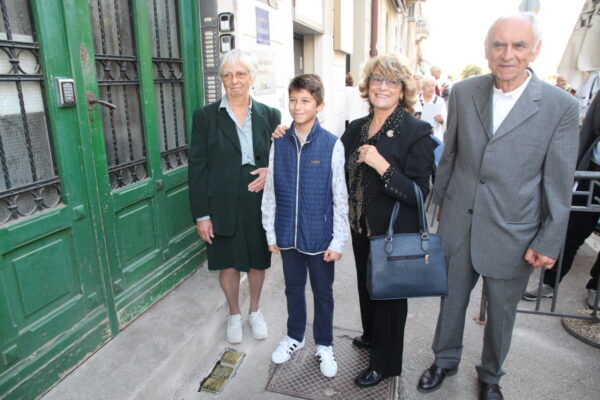
In front of house number 19 on Zagrebačka Street, the so-called “stumbling stones” have been laid to commemorate members of a Jewish family who were taken to Nazi camps during World War II from that address.
Stumbling stones in front of the entrance to the building at Zagrebačka 19 have been laid in memory of Guglielmo and Eugenio Werndorfer and Elena Schwarzenberg, who were taken from that address on 20February 1944 to the Auschwitz concentration camp, where they were killed.
The plaque has been laid on the initiative of Aurelia Werndorfer, the granddaughter of Elena Schwarzenberg and Guglielmo Werndorfer, and the stones have been laid on the pavement in front of the building of her ancestors, thus symbolically returning them to their house, by members of the families of Jews taken to Nazi camps, descendants of sons and daughters who managed to avoid arrest.
On behalf of the family, Aurelia Werndorfer thanked everyone who helped place the stumbling stone.

members of the Werndorfer family and Ellena Schwarzenberg
“For years I have heard about these memorial plaques, created by German artist Günter Demnig to counter the oblivion of the tragedy of the Nazi deportations during World War II. Always bearing in mind the fate experienced by my grandparents and uncle Eugenio, I had a strong desire to place these stones in front of their house in Rijeka, the desire that I shared with my relatives. None of us knew our grandfather and grandmother personally, but the memory of them is still alive”, said Aurelie Werndorfer.
The installation of the stumbling stones was attended by the deputy mayor of Rijeka Sandra Krpan, members of the Werndorfer and Schwarzenberg families, members of the Jewish Municipality of Rijeka, Rabbi Luciano Moše Prelević, who recited Kaddish, and the event was celebrated with a song by the “Fratellanza” choir of the Rijeka Italian Community.
“If people had always respected each other and had been guided by the laws of nature, logic and common sense, according to which we are all the same, regardless of what religion, race or nationality we belong to, then we would not have civilizational black holes in our history, such as the one related to Nazism and the Holocaust, and there would be no need to set up stumbling stones. There would only be a memory of the Werndorfer and Schwarzenberg families who lived and worked in Rijeka. But, unfortunately, as we all know, history wrote a different, black scenario”, said the deputy mayor Krpan.

In front of house number 19 on Zagrebačka Street, stumbling stones have been laid
“With stumbling stones we leave a permanent mark and in this way share memories and pain due to injustice and cruel suffering that was the result of stupidity and depravity”, said the deputy mayor.
“Such memories are particularly important for the young generation, that must know where hatred, intolerance and insanity lead. The Holocaust must never happen again, never anywhere in the world,” concluded Krpan.

STUMBLING STONES WERE LAID BY FAMILY MEMBERS
Guglielmo Werndorfer and Elena Schwarzenberg were Ashkenazi Jews of Austro-Hungarian origin, who arrived in Rijeka in the last decade of the 19th century, where they founded a large family with 12 children. At the Kozala cemetery, there is still a tomb, today a historical monument, of one of them, Ignacio, who died in 1905 at a very young age. Guglielmo Werndorfer was the owner of a cargo transport company and owned Belgian draft horses, suitable for pulling heavy wagons loaded with goods from the port of Rijeka.
In Rijeka, the first stumbling stone was placed in 2013, and so far a total of 12 have been placed in memory of the citizens of Rijeka, victims of the Holocaust. The President of the Jewish Municipality of Rijeka, Ranko Špigl, recalled that Rijeka was the first city in Croatia to install stumbling stones.
The Stumbling Stone project, or originally Stolpersteine in German, was launched in 1996 by the German artist Günter Demnig and the Berlin-based New Association for Painting Art. The project is carried out throughout Europe and represents the installation of memorials to the Jews who died in the Holocaust, and is placed on the pavement in front of the doors of the houses where they lived and from which they were taken.

